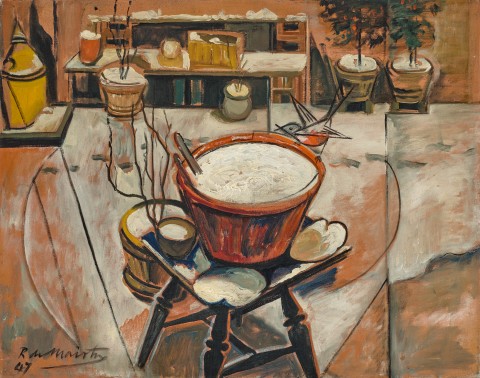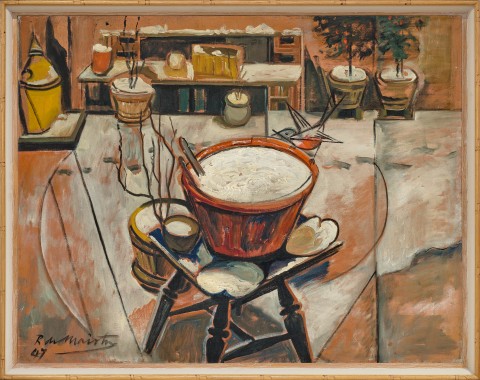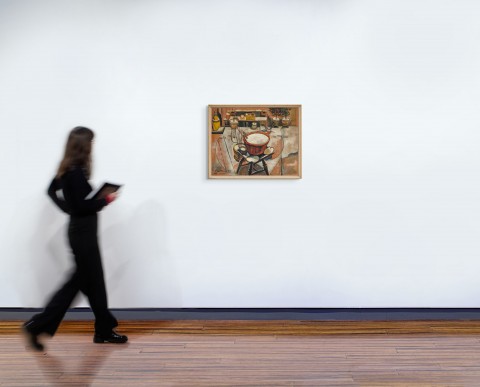(1894 - 1968)
Roy De Maistre
Garden under snow at Ecclestone Street, Pimlico, 1947
oil on canvas
Miss Doris de Mestre Fisher, United Kingdom, acquired directly from the artist
Thence by descent
Caroline de Mestre Walker, United Kingdom
Caroline de Mestre Walker has been co-copyright holder on de Maistre’s work since 1975 and has generously donated her Roy de Maistre archive and papers to the Art Gallery of New South Wales.
After leaving Australia in 1930, Roy de Maistre settled in London, occupying several residences before achieving a permanent home and studio at 13 Eccleston Street in 1937. Partly funded by Sydney Butler – daughter of Samuel Courtauld, first wife of the politician Rab Butler, and generous patron of de Maistre – De Maistre maintained the property by renting rooms to friends and patrons such as Patrick White, Lucy Dynevor (daughter of John Rothenstein) and others.1 Friends variously described de Maistre’s studio as ‘his finest work’; ‘an Aladdin’s cave’; ‘a theatre of his actions and a repository of his whole life’; ‘a brilliant orchestration of cluttered objects’; ‘a dream world’ and ‘an oasis’, stimulating the visual senses and enlivened by flowers and exotic perfume discs.2 Significantly, the largest section of de Maistre’s oeuvre comprises interiors of his studio.
Garden under snow at Ecclestone Street, Pimlico, 1947 offers a rare depiction of the studio garden. Although the subject appears mundane (a backyard), de Maistre has partially stylised it, emphasising the circular shapes of the central bowl, table and background pots and introducing the parallel lines on the left. In contrast to the more painterly surrounds, the robin is a roughly sketched diagram. The red-brown colour palette contrasted with white is unusual in de Maistre’s usual brighter, more carefully modulated and harmonised colour repertoire, but evocative of the bleakness of winter. The picture plane is tilted towards the viewer in the foreground giving the painting a feeling of instability, a sense of seizing the moment – capturing the fleeting scene of the red bird against the white snow. John Rothenstein described de Maistre as staying ‘mostly indoors’3 and this is captured in the work where the outdoors looks about to slide into the viewer’s interior space.
De Maistre’s studio interiors are a suite of structured images with precise arrangements of tables, vases, lamps, flowers and other artifacts thoughtfully placed and meticulously depicted. In striking contrast, Garden under snow at Eccleston Street, Pimlico offers a rare, alternative glimpse into the artist’s informal backyard that could belong to any of us.
1. See Johnson, H., Roy de Maistre. The English Years, Craftsman House, Sydney, 1995, pp. 47 – 48
2. ibid., p. 48
3. Rothenstein, J., ‘Introduction’, Roy de Maistre. A retrospective exhibition of paintings and drawings 1917 – 1960, Whitechapel Art Gallery, London, 1960, p. 9
HEATHER JOHNSON


